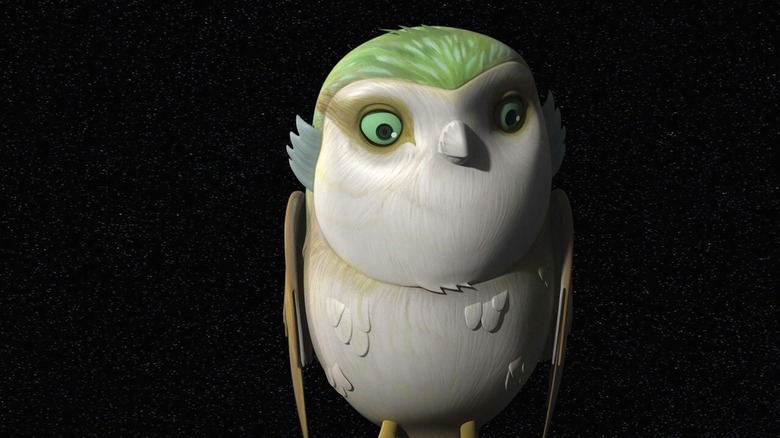The Little White Bird In Ahsoka's Season 1 Finale Has Deep Ties To The Force
This article contains spoilers for the "Ahsoka" season 1 finale, "The Jedi, the Witch, and the Warlord."
Even with Grand Admiral Thrawn (Lars Mikkelsen) escaping to Dathomir, the first season of "Ahsoka" ends on a hopeful note for our heroes. While Ezra (Eman Esfandi) returns home and reunites with Hera (Mary Elizabeth Winstead), Sabine (Natasha Liu Bordizzo) and Ahsoka (Rosario Dawson) hang back in Peridea to help the Noti community feel safe after a patch of chaos. As the two converse and understand one another better, Ahsoka notices a mysterious white owl sitting on a rock and watches the bird with some curiosity. This bird is a Convor named Morai, with personal ties to Ahsoka and the Mortis Gods, whose statues are shown towards the end of the episode.
In order to understand the connection between this bird and those humongous statues, we must first understand what a Convor signifies. Convorees, also known as Trandoshan birds, are a species of owl native to Wasskah, believed to have a strong connection to the Force. Ahsoka's Convor, Morai, has direct ties to the Daughter, one of the three Mortis gods who symbolizes the light side of the Force. The Mortis Gods were introduced in a three-episode arc in "Star Wars: The Clone Wars," where Anakin, Obi-Wan, and Ahsoka were lured into the mysterious realm of Mortis, where the three gods resided.
Along with Daughter, Son (representing the dark side of the Force) and Father (who maintained a balance between the light and the dark) sought to test whether Anakin was the Chosen One, but Son's betrayal led to a series of events that ended in tragedy. Let's break down how Ahsoka was involved in this incident, and what Morai signifies within the context of her potential actions in the future.
Rebirth
The Mortis arc in "Clone Wars" feels disorienting and dreamlike for a reason. The very concept of Force-wielders and a realm that is believed to be the origin of the Force is tricky to perceive and understand. Father, sensing that his days of keeping the balance are numbered, wanted Anakin to take over this demanding job. However, the Jedi refused, and Son plotted against his family to covet more power for himself. In order to do so, he corrupted Ahsoka with the dark side of the Force, which fueled her insecurities and latent thirst for power, leading her to do the Son's bidding without question. Worried about his padawan, Anakin tried his best to intervene, but Son killed Ahsoka once she was rendered useless to him.
When Son charged towards Father with the Mortis Dagger (a blade that can kill Force-gods like them), Daughter got accidentally stabbed when she attempted to shield him. As Anakin grieved Ahsoka, Father channeled some of Daughter's life force into her using Anakin as a conduit. This act brought Ahsoka back to life, granting her a second chance to become the person she is today. Morai is representative of Daughter and her sacrifice, and through this Convor, the Daughter's affinity towards the light side of the Force lives on. Morai has appeared several times in connection to Ahsoka, such as when she flies over Vader when he visits the Tribunal wreckage in "Clone Wars," or when Ezra brings Ahsoka back from the dead (yes, again) in "Star Wars Rebels."
Morai's reappearance at this juncture, coupled with the statues of the gods, points towards the unearthing of an ancient power that probably rests in Mortis. Is Morai trying to warn Ahsoka about the future? Only time will tell.
All episodes of "Ahsoka" season 1 are streaming on Disney+.

